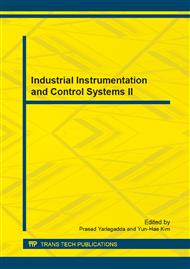[1]
F. Akyildiz, W. Su and Y. Sankarasubramaniam: Computer Networks. Vol. 38 (2002), p.393.
Google Scholar
[2]
O. Younis and S. Fahamy: Proceedings of IEEE INFOCOM 2004. (2004), p.629.
Google Scholar
[3]
K. Akkaya and M. Younis: Ad Hoc Networks. Vol. 3 (2005), p.325.
Google Scholar
[4]
W. Heinzelman, A. Chandrakasan and H. Balakrishnan: IEEE Transactions on Wireless Communications. Vol. 1 (2002).
Google Scholar
[5]
Xu Jia, Jin Ning and Zhonglou Xi: 2012 9th International Conference on (FSKD). (2012), p.2174.
Google Scholar
[6]
B.A. Bakr and L. Lilien: 2011 Fifth International Conference on IMIS. (2011), p.277.
Google Scholar
[7]
T. N. Quynh, K. H. Phung and H. V. Quoc: 2012 ICTC. (2012), p.583.
Google Scholar
[8]
Y.L. Li, L.W. Ding and F. Liu: Proceedings of 2011 International Conference on Computer Science and Network Technology. Vol. 2 (2011), p.1345.
Google Scholar
[9]
Pan Wang: Advances in Information Sciences and Service Sciences. Vol. 4 (2012), p.48.
Google Scholar
[10]
M. Karimi, H. R. Naji and S. Golestani: 2012 ICEE . (2012), p.706.
Google Scholar
[11]
Tripathi and Kr Rajeev: 2012 National Conference on Communications (NCC). (2012), p.1.
Google Scholar
[12]
M. Liu, S. Zhu and P. Dong: 2012 International Conference on Computer Distributed Control and Intelligent Environmental Monitoring. (2012), p.9.
Google Scholar
[13]
W.B. Heinzelman, A.P. Chandrakasan and H. Balakrishnan: IEEE Transactions on Wireless Communications. Vol. 1 (2002), p.660.
Google Scholar
[14]
P. Adonias, S. Claudio and C. Eduardo: 2011 IEEE LATINCOM. (2011), p.1.
Google Scholar
[15]
Zh.X. Deng and B. Sh. Qi: IET Conf. on Wireless, Mobile and Sensor Networks. (2007), p.72.
Google Scholar
[16]
S. Jang, H.Y. Kim and N.U. Kim: 2011 IEEE Inter. RF and Microwave Conf. (2011), p.79.
Google Scholar
[17]
Z. Aliouat and S. Harous: 2012 IIT. (2012), p.194.
Google Scholar
[18]
S. Mao, Ch.L. Zhao and Zh. Zhou: 2011 6th CHINACOM. (2011), p.245.
Google Scholar
[19]
A. Suharjono and H.G. Wirawan: 2011 ICEEI. (2011), p.1.
Google Scholar
[20]
K. Nesrine and J.M. Ben: 2012 ICCIT. (2012), p.308.
Google Scholar
[21]
Ch. Rajni and G. Vrinda: 1st International Conference on Recent Advances in Information Technology. (2012), p.536.
Google Scholar
[22]
R.A. Roseline and P. Sumathi: 2012 International Conference on Devices, Circuits and Systems. (2012), p.365.
Google Scholar
[23]
H.B. Qin, X.D. Zhong and Zh.Y. Xiao: IEEE International Conference on Control and Automation. (2011), p.686.
Google Scholar
[24]
F.L. Tang, I. You and S. Guo: Journal Of Intelligent Manufacturing. Vol. 23 (2012), p.1305.
Google Scholar


